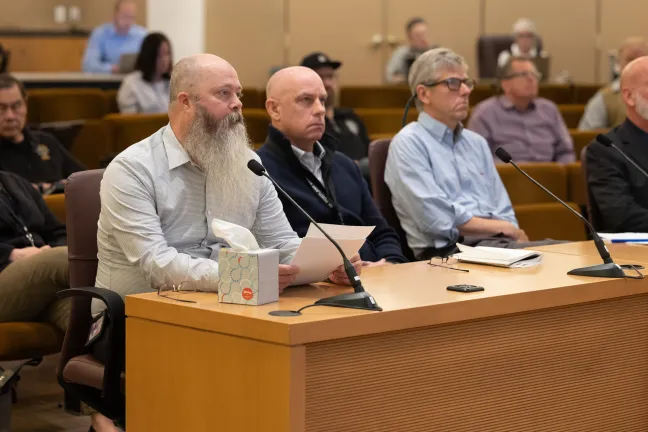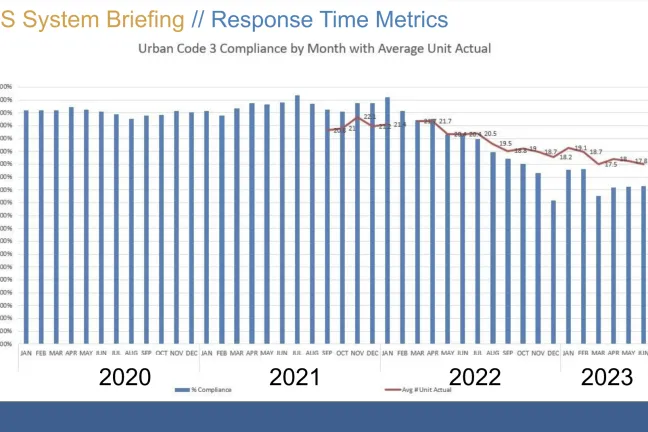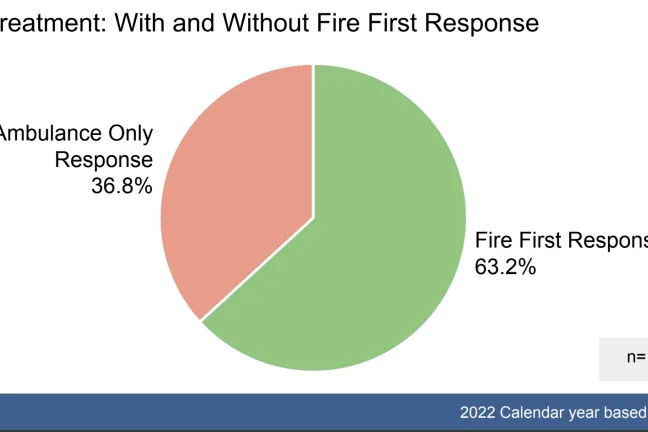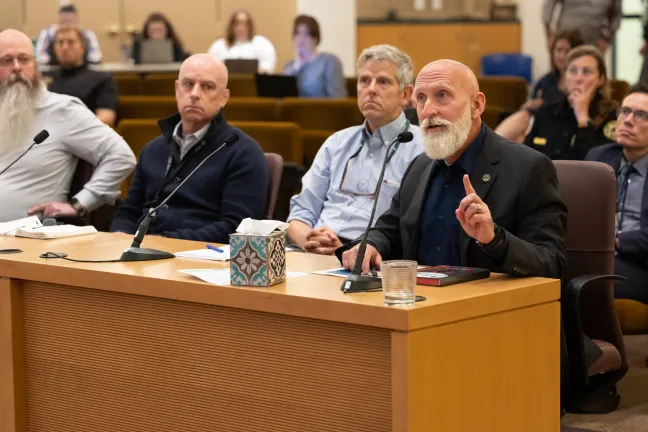In 2022, Multnomah County’s ambulance provider American Medical Response (AMR) responded to 120,478 9-1-1 calls — a 20% increase from 2018, when AMR ambulances responded to 100,369 emergency calls. That surge in demand, officials said, reflects just one dimension of the challenges AMR has experienced in supplying ambulances and staff in a timely manner.
Leaders from the Multnomah County Health Department, the City of Portland’s Bureau of Emergency Communication (BOEC) and the Portland Fire Bureau presented to the Board of County Commissioners Tuesday, Sept. 19, for a briefing about how the County responds to medical emergencies in the face of AMR’s long response times. The presentation came at the request of Chair Jessica Vega Pederson and other members of the Board.
The 9-1-1 emergency medical services (EMS) system in Multnomah County is composed of numerous agencies and providers. The County does not directly operate or subsidize the EMS system, but is instead responsible for the ambulance contract and provides medical direction to ensure all County residents are served.
The County updated its Ambulance Service Plan with the approval of the Board in December 2016 following an engagement process that lasted over a year.
For that reason, the County maintains a uniform system across a geographically diverse region, including a single 9-1-1 call center, operated by the City’s Bureau of Emergency Communications; a single contracted ambulance provider that serves the entire county; and one EMS medical director who directs care standards. Fire departments also respond to the most serious calls.
“Today’s briefing about EMS tells the story of the partnerships we lean on in our emergency management system, as well as the long history of these partnerships,” said Chair Vega Pederson.
“I am grateful that so many of our partners are with us today as we take careful stock of how this system operates at Multnomah County, as well as the things we’re doing to pilot alternative approaches to it.”
On-call Deputy Health Officer Dr. Paul Lewis, a former Multnomah County health officer, started the briefing by sharing an overview of Multnomah County's EMS system while also acknowledging AMR’s inability to maintain contractual compliance with its predetermined response time metric. AMR’s contract with the County says that life-threatening emergencies are expected to receive an ambulance in eight minutes or less at least 90% of the time in an urban setting.
“We must maintain high quality to save lives, but we are not satisfied with the recent decline in response time performance,” said Lewis.
“One goal of our EMS system is to send the right response to the right patient at the right time.”
There are multiple levels of care and treatment in the County’s ambulance response system. Multnomah County EMS Medical Director Dr. Jon Jui explained the two types of providers and responses that are deployed to medical emergencies: Advanced Life Support and Basic Life Support.
“In Multnomah County, Advanced Life Support is equated to a paramedic-level provider,” said Jui. “This provider (has) approximately anywhere from 1,500 to 2,000 hours of training and extensive education, and is a sophisticated provider providing many of the interventions that we actually use in the hospital.”
Advanced Life Support calls are situations triaged as cardiac arrest, respiratory arrest, or an unconscious, unresponsive or altered level of consciousness.
“The second-level provider, just as important, is the basic life support provider,” explained Jui. An emergency medicine technician (EMT) provides care initially to many portions of the community, Jui continued, but the major difference is the administration of medication.
“If you administer medication, that requires a paramedic-level certification. If you do CPR, AED and airway, that is an EMT,” he said.
County Health Officer Operations Manager Aaron Monnig explained that in two-thirds of the 120,478 AMR ambulance responses in 2022, the patient received either care at the Basic Life Support level or no actual care.
Patients in the remaining one-third of responses — approximately 41,000 people — received Advanced Life Support care.
Among patients receiving Advanced Life Support care, 36.8% were responded to by just an ambulance, while the other 63.2% were responded to by both a fire truck with a paramedic onboard and an ambulance with two paramedics.
Monnig stressed the importance of having two paramedics present when only an ambulance arrives at an incident to ensure that Advanced Life Support care can be provided to the patient. This is especially important for the times when, upon arrival, the situation is found to be more serious than what was known when the call was triaged.
“In Multnomah County, a single ambulance alone responds to over 12,000 calls a year that require Advanced Life Support,” said Lewis. “Without two paramedics per ambulance, we could not have a high-quality response.”
Fire departments independently determine what calls they will respond to. Of all 9-1-1 calls, 44.5% were responded to only by an ambulance. The other 55.5% of calls received both a fire truck response with a paramedic onboard and an ambulance with two paramedics.
Monnig explained that fire departments in neighboring counties respond to 95 to 100% of all 9-1-1 calls, with each fire truck deploying with a paramedic, which allows their ambulances to deploy with a single paramedic. This means that all calls have two paramedics split between the fire and ambulance response.
That setup “is also the right care at the right time with the right people, but it’s structured fundamentally different from this county,” said Monnig.
“It is worth noting that our neighboring counties are also struggling with response times and rates of ‘Level Zero,’” he continued, referring to the times when there are zero ambulances available to respond to a 9-1-1 call.
Multnomah County has a high-performing system with clinical outcomes in the top 10% of the nation, Monnig explained, but the system continues to face two key challenges: workforce shortages and increased 9-1-1 call volume.
“To be clear, everyone recognizes there is a problem,” he said.
“The County sees that the contract requirements are not being met by the contractor, AMR. AMR sees that their response times are not meeting the requirements, and at least in part that is due to staffing. Our first response agencies see that their people and equipment are on scene longer providing treatment to patients for longer time frames due to delayed ambulance times. We have an issue that we have been addressing that is maintaining the staffing of the ALS emergency ambulances for treatment of the most critical of patients.”
The County has put two pilot programs in place to solve some of the short-term problems until AMR can hire more staff, Monnig said.
With one new change, 9-1-1 calls that BOEC triages as a lower-acuity call type are sent to an AMR paramedic who calls the patient, then assesses and manages the call until sufficient ambulances are available to cover both high-acuity calls and the lower-acuity call.
“This reduces the likelihood of the system’s ambulances from being depleted on lower-acuity calls that could delay dispatch to the higher-acuity calls,” said Monnig. Approximately 45 calls a day are routed through this new process. The average time a patient is managed by a paramedic over the phone has been about 20 minutes, but that range can be wide depending on how busy the EMS system is.
The second change has been adding Basic Life Support non-emergency ambulances with two emergency medicine technicians rather than two paramedics as an available dispatch option. The Basic Life Support ambulances respond to a subset of non-emergency lower-acuity calls.
Of the roughly 40 calls they could take, these two-EMT Basic Life Support ambulances are currently responding and transporting on average 14 patients per day — slightly less than 40% of all the eligible calls they could go on. AMR has hired and deployed a total of nine EMTs since December 2022 when the Basic Life Support pilot was initiated.
“Deploying the new Basic Life Support ambulances maintains the two-paramedic Advanced Life Support ambulances for the higher-acuity calls,” said Monnig. “However, there are not enough EMTs. We have nine. We need about 40 to effectively take all these calls out of the 9-1-1 system.”
City of Portland EMS partners
The City of Portland’s Bureau of Emergency Communication’s primary mission is providing 9-1-1 dispatch services for the entire county. BOEC Director Bob Cozzie spoke about the public safety partnership the County and the City leverage to discern and triage between emergency and non-emergency 9-1-1 calls.
“9-1-1 is a barometer of the condition of any community,” said Cozzie. “What we’re experiencing in 9-1-1 really just magnifies what’s happening at the community level. Since 2018 — which I would argue was probably the last kind of normal year that we had — 9-1-1 calls increased by 48%.”
Cozzie shared that BOEC is actively working toward becoming accredited by the International Academies of Emergency Dispatch through ongoing training and incentivizing dispatchers that they receive a raise once the agency reaches accreditation.
“We want to provide the best service for our community,” said Cozzie.
To reach accreditation, 9-1-1 dispatchers need to improve the way instructions are provided to a caller after an ambulance is dispatched.
“We’re nailing it right about 95% of the time across the board when it comes to determining the correct response. Our goal is to be 100%,” said Cozzie.
“The accreditation would allow the City and the County to take advantage of an internationally validated system that would allow much finer-detailed dispatch to the highest-acuity resources with multiple responders to the high-acuity calls, and a very basic level to the other calls,” said Lewis. “Upon reaching accreditation, they’ll have the confidence and liability protection to be able to do that.”
Mike Myers, the director of the City of Portland Public Safety Division, spoke to why a change to the 9-1-1 system is warranted to get the right response to the right call.
“We have always advertised to people to call 9-1-1 for any kind of emergency that they needed and we were able to manage that call volume for decades,” he said. “We’re getting to the point over time nationally — Portland is not alone in this issue — where it’s simply unable to manage the sheer amount of call volume. There is a need to separate out the non-emergency call volume and emergency call volume.”
The City of Portland commissioned a report to see how many calls could potentially receive an alternative response. Myers explained that the study showed that roughly 30% of all 9-1-1 calls might be able to receive an alternative response.
“We can’t continue to manage the 9-1-1 center by allowing calls to come in and transfer them to traditional sources of police, fire and medical like we’re doing today and plan on being efficient tomorrow,” said Myers.
Lewis concluded the presentation with an emphasis on how all partners in the EMS system are focused on trying to get the right resource to the people in need at the right time. He also shared a personal story on his own medical scares.
“Since 2020, I’ve gotten to see the healthcare system flat on my back full of tubes and wires mostly in my arteries. Just three months ago, I had yet another artery pop open, this time in my heart. And for the sake of my family, I hope that when it plugs up that I get Portland Fire and AMR to revive me.”
Board Comment
Commissioner Julia Brim-Edwards acknowledged that all the work that happens throughout the EMS system is really appreciated by those who receive it. “When somebody needs a response and they call 9-1-1, the feeling of relief when the right care shows up in a responsive way, it's life-changing for families in a very positive way.”
Commissioner Brim-Edwards asked if the specific goals and metrics of the two new short-term solutions that have been implemented would result in an improvement in response times.
Monnig responded that the Basic Life Support ambulances that are currently on the road are not enough.
“We saw the volume of times when an ambulance was not immediately available dropped fairly quickly after we started dispatching Basic Life Support ambulances on non-emergency calls,” he said. “We’re still seeing Level Zero, but the durations are getting shorter. We need to hit a critical mass of EMTs and Basic Life Support ambulances out on the road actually taking those calls before we’re really going to see the true benefits.”
Commissioner Lori Stegmann thanked the group, then asked what about the County’s response time for non-life-threatening incidents.
Monnig responded that AMR is also taking longer on these calls, but they are not time critical, life-threatening issues compared to the Advanced Life Saving calls. Non-life-threatening responses are the ambulance only with no lights and sirens calls, and these calls are supposed to be responded to in under 20 minutes 90% of the time.
Commissioner Sharon Meieran suggested that the Board should be looking at a change in ambulance staffing to meet the standard of care similar to the one-paramedic, one EMT staffing model found in most other jurisdictions.
“Hiring more EMTs is possible, but the number of paramedics is not going to change in the next year to two years,” said Commissioner Meieran.
“The pilot that is being proposed, it might do some good, but it’s like putting a Band-Aid on an arterial bleed. The tourniquet that can stop the bleeding temporarily as we’re doing all sorts of other stuff which we have to do is changing the staffing model to meet the rest of the state and the country’s national standard.”
Commissioner Susheela Jayapal shared a story of her father’s fall in the middle of the night last year in India. “My mother had to wait for an hour for an ambulance. I sat with her on the phone while she was waiting. I understand what community members are feeling as they sit and wait for help in these situations.”
Commissioner Jayapal also requested more information on why fire departments are not responding to 36.8% of all Advanced Life Support calls.
“We all want to see the response and the outcomes for people who are in critical medical situations that, when they call 9-1-1, when they need the help, people are getting the type of help they need, when they need it,” said Chair Vega Pederson. “And that’s ultimately what we’re all here to do.”




